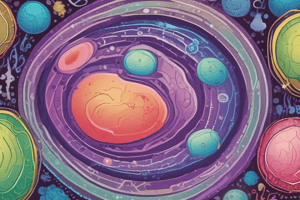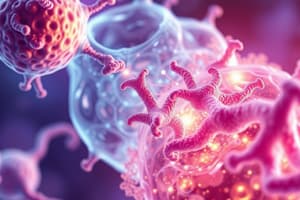Podcast
Questions and Answers
RNA polymerase binds to the start of that sequence (This involves energy from ATP and phosphorylation of the receptor) RNA polymerase does two things: i. Unzips that sequence of codons ii. Pairs free ribonucleotides found in the nucleus to the corresponding deoxyribonucleotide of the antisense strand of DNA. The ribonucleotides are bound together to form messenger RNA (mRNA) This.
RNA polymerase binds to the start of that sequence (This involves energy from ATP and phosphorylation of the receptor) RNA polymerase does two things: i. Unzips that sequence of codons ii. Pairs free ribonucleotides found in the nucleus to the corresponding deoxyribonucleotide of the antisense strand of DNA. The ribonucleotides are bound together to form messenger RNA (mRNA) This.
process is known as transcription
Adenine pairs to thymine (or uracil on RNA) Guanine pairs to cytosine A-T (or U) C- G 4 2 13/07/2020 Transcription: This occurs in the nucleus A transcription factor binds to a receptor on DNA associated with a specific sequence of codons (a gene) Transcription factors may be hormones or other intracellular chemicals (ligands) An enzyme known as RNA polymerase binds to the start of that sequence (This involves energy from ATP and phosphorylation of the receptor) RNA polymerase does two things: i. Unzips that sequence of codons ii. Pairs free ribonucleotides found in the nucleus to the corresponding deoxyribonucleotide of the antisense strand of DNA. The ribonucleotides are bound together to form messenger RNA (mRNA)
Adenine pairs to thymine (or uracil on RNA) Guanine pairs to cytosine A-T (or U) C- G 4 2 13/07/2020 Transcription: This occurs in the nucleus A transcription factor binds to a receptor on DNA associated with a specific sequence of codons (a gene) Transcription factors may be hormones or other intracellular chemicals (ligands) An enzyme known as RNA polymerase binds to the start of that sequence (This involves energy from ATP and phosphorylation of the receptor) RNA polymerase does two things: i. Unzips that sequence of codons ii. Pairs free ribonucleotides found in the nucleus to the corresponding deoxyribonucleotide of the antisense strand of DNA. The ribonucleotides are bound together to form messenger RNA (mRNA)
process is the initial step of gene expression
A transcription factor binds to a receptor on DNA associated with a specific sequence of codons (a gene) Transcription factors may be hormones or other intracellular chemicals (ligands) An enzyme known as RNA polymerase binds to the start of that sequence (This involves energy from ATP and phosphorylation of the receptor)
A transcription factor binds to a receptor on DNA associated with a specific sequence of codons (a gene) Transcription factors may be hormones or other intracellular chemicals (ligands) An enzyme known as RNA polymerase binds to the start of that sequence (This involves energy from ATP and phosphorylation of the receptor)
process is called initiation
Pairs free ribonucleotides found in the nucleus to the corresponding deoxyribonucleotide of the antisense strand of DNA. The ribonucleotides are bound together to form messenger RNA (mRNA) This.
Pairs free ribonucleotides found in the nucleus to the corresponding deoxyribonucleotide of the antisense strand of DNA. The ribonucleotides are bound together to form messenger RNA (mRNA) This.
RNA polymerase binds to the start of that sequence (This involves energy from ATP and phosphorylation of the receptor) RNA polymerase does two things: i. Unzips that sequence of codons ii. Pairs free ribonucleotides found in the nucleus to the corresponding deoxyribonucleotide of the antisense strand of DNA.
RNA polymerase binds to the start of that sequence (This involves energy from ATP and phosphorylation of the receptor) RNA polymerase does two things: i. Unzips that sequence of codons ii. Pairs free ribonucleotides found in the nucleus to the corresponding deoxyribonucleotide of the antisense strand of DNA.
Explain the process of transcription in eukaryotic cells, including the role of RNA polymerase and the formation of messenger RNA (mRNA).
Explain the process of transcription in eukaryotic cells, including the role of RNA polymerase and the formation of messenger RNA (mRNA).
Describe the pairing of nucleobases during transcription, including the specific base pairs and their roles.
Describe the pairing of nucleobases during transcription, including the specific base pairs and their roles.
What is the function of transcription factors in the process of transcription?
What is the function of transcription factors in the process of transcription?
Explain the energy requirements and enzymatic activities involved in the process of transcription.
Explain the energy requirements and enzymatic activities involved in the process of transcription.
How are ribonucleotides paired to the antisense strand of DNA during transcription, and what is the resulting product?
How are ribonucleotides paired to the antisense strand of DNA during transcription, and what is the resulting product?
Flashcards are hidden until you start studying




